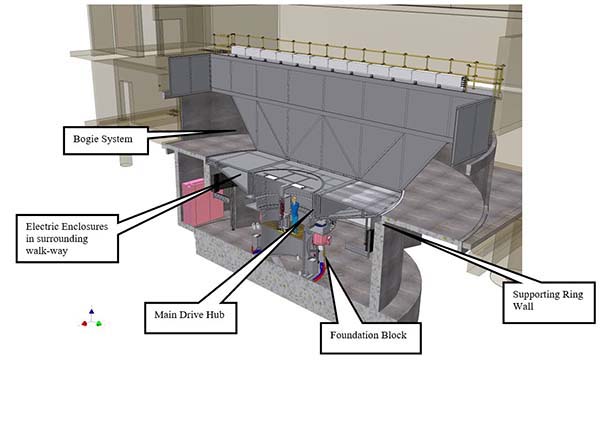3-D Dynamic Finite Element Analysis and Foundation Design for Pilot-Training Centrifuges at WPAFB and Multiple Locations Worldwide
Overview: GeoStructures has been working on several centrifuge projects for Environmental Tectonics Corporation (ETC) since 2009. ETC is a design-build-operate contractor in the air force sector with products in over 90 countries throughout the world. GeoStructures services comprised subsurface investigations, vibration analyses and foundation designs for a High-G centrifuge and multiple disorientation research centrifuges at Wright Paterson Air Force Base (WPAFB) in Dayton Ohio and worldwide. Centrifuges create bidirectional acceleration forces, resulting in rotational radial thrust and overturning moment, vertical stresses (upward or downward), and torsion, which have to be safely resisted by their foundations and the surrounding earth. At the same time, the vibration levels should not harm the centrifuge operation or adversely impact any adjacent sensitive equipment.
Highlights & Related Services:
Highlights & Related Services:
Test borings with rock coring
Shelby tube sampling
Geophysical testing
Dynamic soil-structure interaction analysis
On all of these highly sensitive projects, GeoStructures conducted test borings with rock coring, Shelby tube sampling, and sometimes geophysical testing (MASW and downhole seismic) to characterize the various sites in detail and obtain the necessary subsurface information for dynamic soil-structure interaction analysis. In addition to index and unconfined strength tests, resonant-column tests were often performed on undisturbed clayey soils to accurately measure the shear modulus and damping behaviors. Pulse velocity (compression and shear waves) tests were also carried out on intact rock samples to determine shear wave velocities.
Foundation blocks were proposed to support the various centrifuges based on the subsurface conditions and the magnitude of loading. Dynamic soil-structure interaction analyses were then performed by using powerful 3-D finite element programs such as Abaqus. The entire building and surrounding area including the machine pit and foundation were meshed in Abaqus/CAE. Transient/rotational loading from the machine was realistically simulated in the model.
The analysis provided real-time ground vibration level at various distances from the centrifuge. The results indicated that the ground vibrations were well-below the threshold level and that the proposed foundation block was adequate. The analysis also provided the stresses and strains in the foundation system, which were then utilized for the structural design of the foundation.
PennDOT Approved Contractor
GeoStructures is now approved as a PennDOT Prequalified Geotechnical Drilling Contractor. ...
2021 Project of the Year
GeoStructures is the proud recipient of the Delaware Valley Geo-Institute 2021 Project of the...
2019 Project of the Year
GeoStructures is the proud recipient of the American Society of Civil Engineers 2019 Project of...
Connect with us.
Providing state-of-the-art geotechnical engineering services with an unwavering commitment to excellence and innovation.





